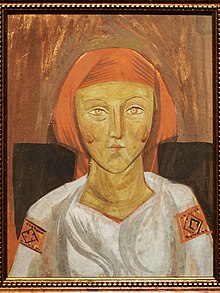Boychukism

Boychukismis a cultural and artistic phenomenon in the history ofUkrainian artof 1910–1930s, distinguished by its artistic monumental-synthetic style.[1]
The basis of Boychuk's concept of the development of new art was an appeal to the traditions of Byzantine and Italian monumental painting, as well as middle-age Rus' icon painting, as the primary source of the Ukrainian national form.
The name comes from the name of the founder of the movement:Mykhailo Boychuk,a muralist and graphic artist. Boychuk, as well as several other artists, made Soviet propaganda and promoted communism. However, Boychuk was labelled as a "bourgeois nationalist" byJoseph Stalin,and he was executed.[2]
At the end of 1925, the Association of Revolutionary Art of Ukraine (ARIU) was founded in Kyiv, uniting Boychukists.[3]
Gallery
[edit]-
Shevchenko holiday, Mikhail Boychuk, 1920
-
M. Padalka. Sketch of an illustration for “The Tale of Igor’s Campaign,” 1928.
-
Sedlyar, Vasily Teofanovich, “At the school of educational programs”, the limit of the 1920-1930s.
-
Shekhtman, Manuil Iosifovich “Jewish pogrom”, 1926.
-
L. Lozovsky. Illustration, “Instead of sonnets and octaves”, Tychina, Pavel Grigorievich, 1920
-
Nalepinskaya-Boychuk, Sofya Alexandrovna, “Girls with a book”, 1927
-
Mezhyhirya nativity scene, 1923
References
[edit]- ^"Exhibition: 'In the Eye of the Storm: Modernism in Ukraine, 1900-1930s' at the Thyssen-Bornemisza Museum, Madrid".
- ^Kurkov, Andreĭ; Puchkov, A. A.; Raffensperger, Christian; Klochko, Diana; I︠A︡remenko, Maksym; Lozhkina, Alisa; Mudrak, Myroslava; Solovjov, Oleksandr; Burlaka, Viktoriya, eds. (2022).Treasures of Ukraine: a nation's cultural heritage.London; New York, New York: Thames & Hudson.ISBN978-0-500-02603-8.OCLC1327835684.
- ^"Ukrainian identity in art: philosophical contours of boychukism".







